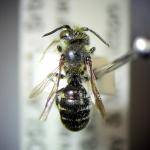In Britain, Hoplitis claviventris was formerly misidentified as H. leucomelana (Yarrow, 1970).
Else & Edwards (in press) will cover this species. It has also been covered in numerous other works, including Banaszak & Romasenko (2001) and Amiet et al. (2004).
The sole British record, the type of the species, was a female taken by Kirby at Coddenham, East Suffolk, prior to 1802. There is an old but post-1900 record from Scotland, an importation.
It is a Palaearctic bee found from France and Spain in the west to China in the east.
Listed in Shirt (1987) in the Appendix (Extinct) as there are no post-1900 records of this species in Britain. Else & Edwards (in press) suggest that the bee is very rare and probably not native to Britain.
The British record was taken in a pinetum but more usual habitats are likely to be flowery open sites from heathland to grassland with ruderal areas or scrub fringe.
Kirby (1802) describes his example as being taken “some time in the autumn”. In Turkey it flies from late May to early July.
This species is a stem-nester utilising pithy plants such as bramble and rose and has also been recorded from the twigs of trees including ash and hazel. It is also noted as using the vacated cavities created by reed galls of the chloropid fly genus Lipara.
A polylectic species which probably feeds on nectar from a wide range of flowers from Fabaceae to Asteraceae; Kirby’s example was taken on a flower of hawkbit.
In continental Europe Stelis ornatula (Klug) is a cleptoparasite of Hoplitis species, including H. leucomelana.
2019


